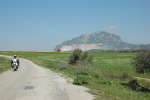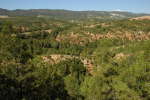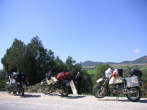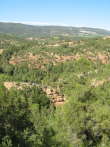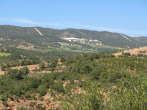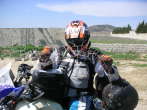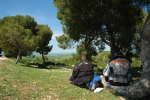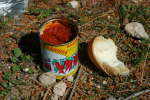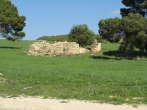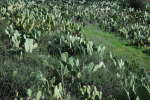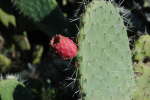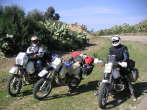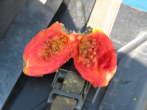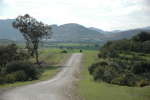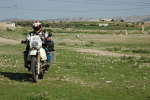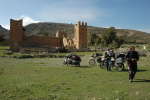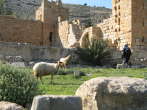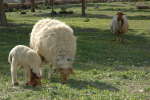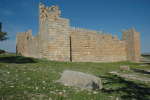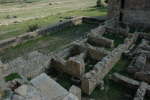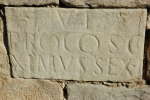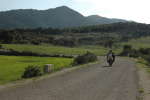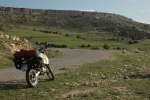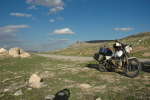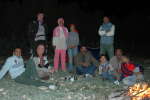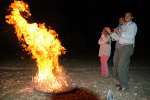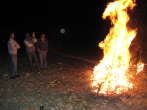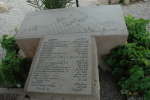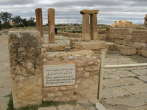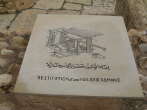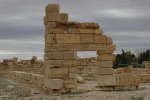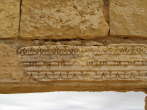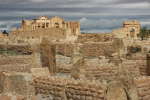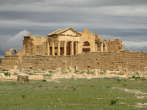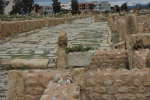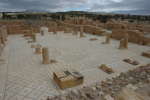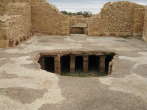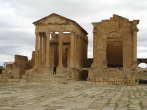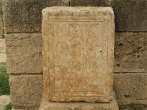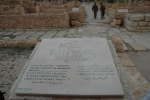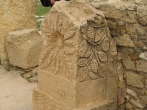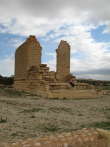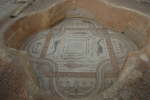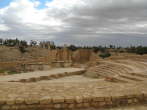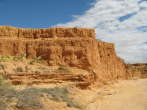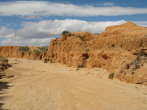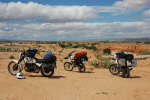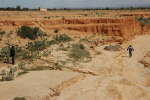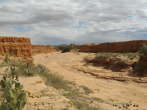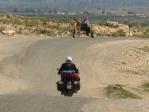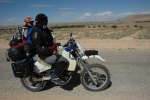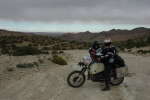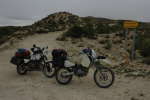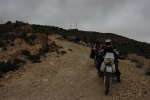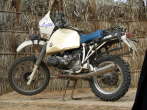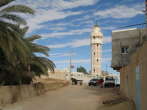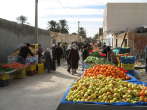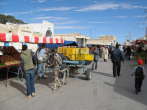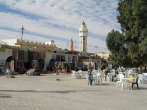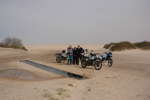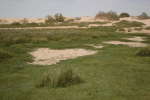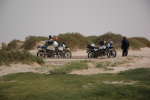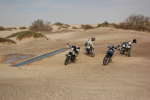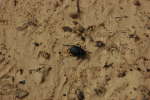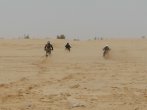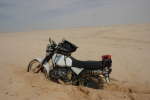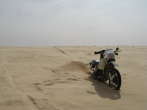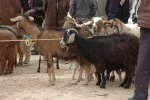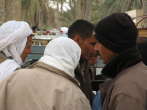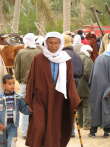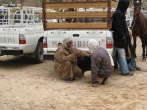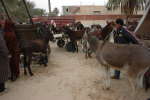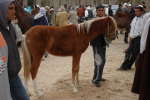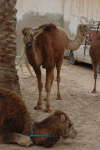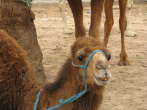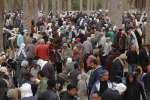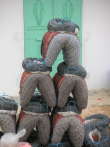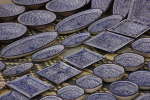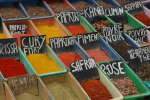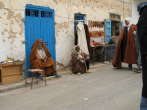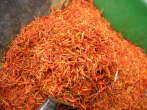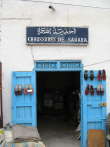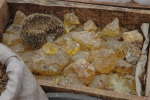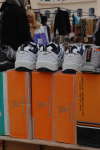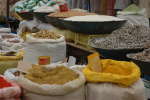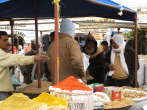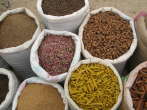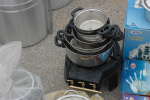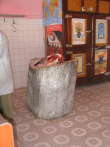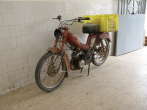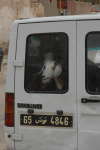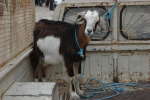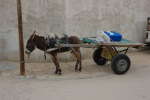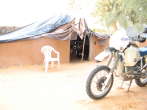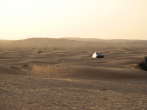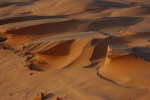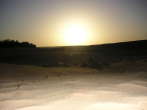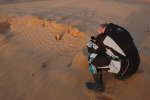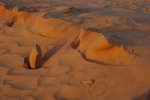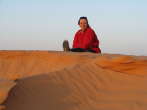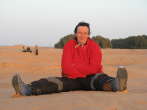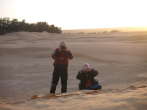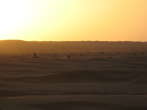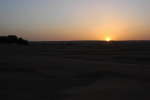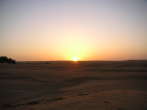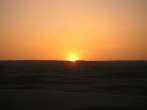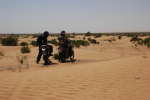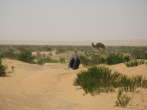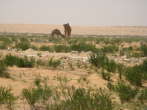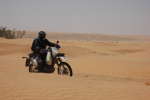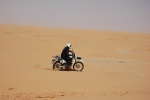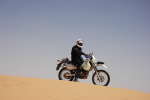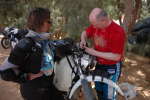Tunisia, March 2007 (Part I)
Home |
Motorcycle Pages |
Forward to Part II
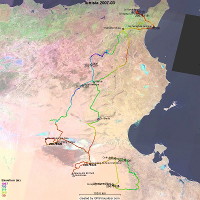
We travelled in Tunisia from March 16 to 31, 2007. "We", this means Petra on her 1995 Suzuki DR350SE,
Florian on Petras Lotte (a 1973 BMW R75/5 modified by Schek long time ago and equipped with a recent 1000-ccm engine) and yours truly on his 1990 BMW R80GS.
We spent a total of 13 days in Tunisia and rode 2200 km in that time, plus the two to three days of
"transit time" in Europe and on the ferry.
- This trip report is spread over two pages. They may take a while to load, but still only a little
selection of the 1400+ photos that we took are displayed ;-)
This trip has been published, albeit in a much shorter form, in the German magazine
MotorradAbenteuer 2/2010, 66-73.
Photos with names ending in -j are © by Jörg, those ending in -p by Petra and -f by Florian.
Top | Slideshow
Start!
Holidays!
Petra and Florian had arrived on the evening before and of course they had all their material packed and were ready to go.
I had been working on the day before and barely started packing on this friday morning. It was a slightly cold, but sunny day.
One of the challenges we faced was to pack three motorcycles - two of them pretty "large" BMW boxer engines - onto a trailer that was originally designed for two bikes.
After a number of trial-and-error experiments, the task was solved by removing both footpegs and a part of the luggage carrier
of the DR350, removing the left crashbar and handguard of the R80GS and a number of small parts from Lotte, a Schek R75/5 with 1000-ccm engine.
Leaving Lausanne at about lunchtime, we took the highway, passed the Grand St-Bernard tunnel towards Italy and down to the Aosta valley.
From there, we stayed on the highway for the next few hours.
Our plan was to leave car and trailer somewhere in the mountains north of Genoa, since most camping areas near Genoa reportedly charge rather high prices.
Petra had found and reserved a suitable camping area and we arrived there at about 19:30. Officially the site was not yet open
(actually undergoing major transformations and renovations at that time), but the owner and his dog both turned out to be very kind.
We put up our tents, then reassembled the bikes (which went much faster than expected) and went down to the village for a
Pizza in the excellent Trattoria.
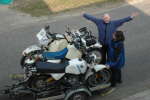
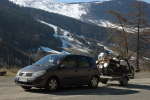
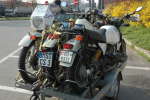
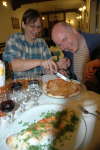
Top | Slideshow
Leaving Italy
We woke up early and packed our tents, as well as all the other material that we thought we'd need in the two coming weeks. Since we were leaving for Africa,
I decided that I could leave the winter liner of my motorcycle vest in Italy (in the car at the camping). I did not yet know that this was an error.
Shortly after leaving the camping area, I performed a little check of my bike's electrics. Switching on the heated grips, the GPS went dark ... and would not
start again. The voltmeter was no longer operational, too ... and since all there were operated from the auxiliary power circuit of the bike, it was
clear that the fuse was blown. I wondered about that but decided to change the fuse later on, in the harbour. We rode on.
A few minutes later I noticed the well-known smell of a hot clutch or brakes. Approaching Florian on Lotte, the smell got stronger ... and indeed his rear
brake was smoking! I waved him to a stop and it turned out that the rear brake had simply been over-tightened when it was reassembled on the evening before.
While the brake was cooling down, I changed the blown fuse, then we continued.
I soon blew the fuse a second time when my tankbag collided with the switch of the heated grips ... so something must have gone wrong with those cables.
Anyway, we reached Genoa and ... committed the error to actually enter the city. Dense traffic and bad or absent signing gave us a hard time. At a gas station I asked for directions to the harbour and for spare fuses
(now that I had already blown two of them) and received both free of charge ;-)
- Genoa city traffic is indeed pretty dense and car drivers are pretty much reckless, so it is probably a better idea to enter the highway already
before you actually reach the city of Genoa. The exit you need to look for is "Genova-Ovest".
Arriving in the harbour area, we were directed in a zig-zag course towards the place of the Carthage ferry, where a first control of the paperwork
took place. I took my sunglasses off, pulled my "standard" glasses out of my pocket and ... noticed that the frame was broken on one side.
Well, was this going to be a "what else can happen" trip?
Anyway, we parked the bikes - they are usually grouped at the "far end" of the long white building at the waterfront - and proceeded to fill in the necessary forms.
Once the customs officers showed up, all the paperwork was done pretty quickly and we gathered at the bikes again. The long wait was shortened by many
discussions with the other motorcyclists - a total of about 30, plus a huge group of italian motorists that arrived
a bit later. It seems that such a large number of motorcycles is somewhat unusual.
Concerning the heated grips, I presumed that we had inadvertely ripped one of the coaxial cables of the heated grips with the tie-down straps yesterday,
but could not find it right now. Anyway, we were heading for Africa, so I certainly would not need heated grips for the next two weeks! Instead of searching the broken cable I simply decided
to disable the heated grips and pulled their plug. This was the second error.
Two weeks later, it turned out that one of the cables was indeed damaged. This had happened when the left handguard was re-attached;
its nut had sectioned the cable to the heated grip and caused a short circuit.
We could enter the ferry at about 18 o'clock. The Carthage is the flagship of CTN, the Compagnie Tunisienne de Navigation. In service since 1999, it is a modern ship that offers place for about 2200 passengers and more than 600 cars.
Upon entering, the bikes are grouped together and "secured" with some ropes, then you have to leave the deck.
Since it is not possible to access the bike during the passage, you have to carry all that you need with you - and an additional obstacle is the fact
that the stairs are pretty tight on the lower decks (our motorcycles were on deck 4, our cabin on deck 6). Thus, we quickly found that we had not done
a very good job in packing, since we carried way too many "parts" with us and through the staircases.
(We improved our skills two weeks later ... for my part, I found it most useful to leave the hardbags and the - almost empty - tank bag on the bike,
attach the helmet with a lock and take only one piece of luggage with me ... such as the tail bag, which should contain all you need for the
next 24 hours.)
Our cabin was on the inner part of deck 6, which meant "no windows", but since we intended to use the cabin only for sleeping this did not matter anyway.
Indeed the cabins are small but well equipped (air conditioning, shower, toilet). After lunch in one of the three restaurants of the ship, we queued for
the next part of the paperwork: The vehicules have to be inscribed in the passport, so you need to fill in several forms and pass through three different
counters, each with its own waiting queue. These counters were located near the rear stairs of the ship on deck 6 and the procedure took quite a while - but
it was not annoying at all, since we easily made contact with our "neighbours" in the queue.
Having obtained all the stamps we needed for now, we went to bed. It was a calm night and a calm sea and there were still about 18 hours to go until
we would reach Africa.
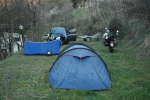
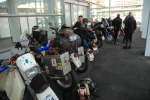
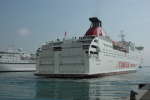
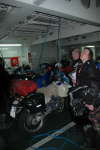
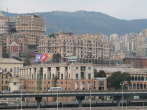
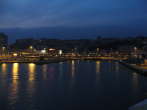
Top | Slideshow
Africa!
Almost the whole sunday was spent on the ferry. We were supposed to arrive in Tunis early afternoon, but the ship had
to wait ... a french ferry that had occupied "our" place in the harbour caused a full 5 hours of delay!
We came off the ferry just before sunset and were guided through customs very fast and very friendly. Hint: have all the papers ready that you received
the evening before. I attached them to the top of my tank bag with a rubber strap.
By the way, nobody asked for the GPSr, albeit these were visibly mounted on the bikes and had been switched on.
From the experience we made one year later, it seems that this was an exception; we were probably waved
through due to the late artrival and the huge number of vehicles.
Leaving the harbour area, the fastest way out of Tunis towards the south is the small ferry that operates during the day (no fee) and that ensures the connection to Radès.
It is easily to find by following the signs to "Bac de la Goulette" and motorcycles are usually waved to bypass the waiting cars and to run
directly on the ferry. Again we noticed that the Tunisian population is generally very friendly: people sitting in their cars next to the bikes
opened the windows, started smalltalk, gave us a warm welcome and wished us a nice stay. A great feeling!
Since we were arriving on a sunday evening at sunset, it was sure that no bank counter was open - but then, we had no money to pay anything.
The problem was quickly solved by Florian, who stopped at the next "Bancomat" and found that you can indeed use these with an European EC card.
In the following days we saw these in almost any city, so obtaining TD (Tunisian Dinar) with an EC-card is really no problem.
We followed the road to Hammam Lif, found the camping easily and readily accepted the owner's offer to spend the night in a concrete "bungalow"
instead of putting up the tents in the dark. After enjoying the sandwiches that Petra had bought along the roadside we made a short walk to the beach
at night and then dropped into our sleeping bags.
We were in Africa.
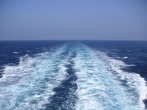
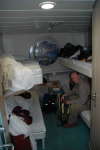
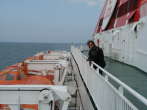
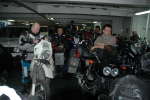
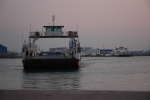
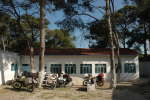
Logistics
- Camping: "La Pinede" in Hammam Lif; 9 TD/pers.
- Total: 29 km.
Top | Slideshow
Top | Slideshow
Grrr, those dogs ...
The evening with the discussions around the campfire had been wonderful. Not so wonderful was the fact that wild dogs in Tunisia tend to have long, very
long discussions, from one village to the next. If one dog stops, the next one chimes in. And their conversations are not varying a lot either, but they
keep you from sleeping. Or at least me, until I used earplugs.
I had not slept a lot and I woke up early. Peeking out of the tent, I realised that it was windy again and a light rain was drizzling on the tents.
The three youngsters that, after the evening before, had spent the night in a small shed nearby were still sleeping.
We started packing early, in a mixture of cold wind and rain under a gray sky. I was the first to start the engine and to roll back to the street and on
that short strip I was "accompanied" by four of the dogs that had kept us awake during the night. They did not really look as if they wanted to play but
looked rather menacing ... but fortunately they turned away as soon as I reached the street.
A few minutes later, Florian and Petra came along. The dogs turned onto them and one of the four apparently wanted to stop Florian by cutting into his
way ... with the simple result that Florian just ran over the dog, which did a full rotation under his front wheel, then barely escaped just before it got
catched by the rear wheel. Stunned, the other three dogs stopped immediately and turned away quickly. I hope they learned their lesson ;-)
We stopped for breakfast in the next village, Sbiba. The view of three geared-up motorcyclists is probably a bit unusual in these villages, but
we were always received very friendly and the hot coffee and tea warmed our fingers (remember that my heated grips were disabled?).
Due to the cold weather we decided to change our programme a bit and to head for the south as soon as possible.
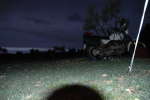
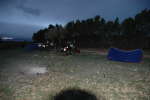
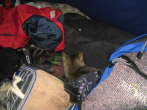
"The weather is a little bit unstable today"
Following the road down into the valley, we gassed up in El Guettar under a yellow raincloud. The few drops that fell seemed indeed to be
composed more of sand than of water and all of us were covered with a thin yellow layer within minutes.
From El Guettar, our path led us across Chott el Jerid. Climbing up the C103 on the last mountains just north of the Chott,
we ran into our first military control.
The personnel at the control post was very kind, but he was the only one during the whole trip that they noted down our passport numbers. Since this appeared
a bit unusual to me, I asked him if this was a routine control or if they were looking someone in partiucular and he replied that "this is just a routine,
but the weather above the Chott is a bit unstable today. Just as a precaution, we prefer to know that there are three motorcyclists that entered the Chott,
so you should reappear at the other side, too". Now that sounded really good; they take care about us!
A few kilometers down the road we understood what he meant by "the weather above the Chott is a little bit unstable today".
First, the previously glazing sun became an opaque disc in the sky and then it disappeard completely.
We entered the Chott and were in a sand storm.
Actually it was not the kind of sand storm that is often reported in desert ride reports, i.e. where your visibility is just a few feet, but it was an,
uhm, remarkable experience nevertheless. With a visibility ranging between a few meters and 200 m, we were following the tarmac towards Kebili,
riding in a straight line ... but with a significant inclination to the right to compensate for the wind that came at an angle of almost exactly 90 degrees.
This went on for about 70 km and we were counting down the distance by the markers of the roadside and watching the GPS.
I was not exactly worrying - there were cars and we were three people with three motorcycles-, but I was nevertheless hoping that we would not have any
technical problem - some clogged air filter, or a flat tire - in that storm.
And we arrived without problems. Passing through Kebili, we headed for Douz and arrived at the camping. A long shower removed the sand from
our skin and then it was time to get something to eat. We went to a restaurant in Douz and successfully tried the local dishes, then fell into our sleeping bags.
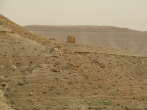
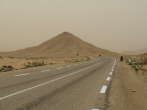
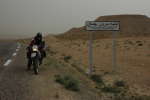
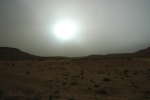
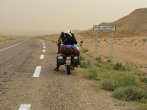
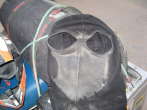
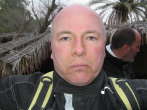
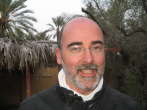
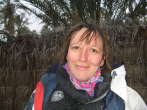
Logistics
- Sbeïtla, roman ruins: Entrance 3 TD/pers, photography 1 TD.
- Camping in Douz: Desert Club, 8 TD/pers.; breakfast 3 TD/pers.
- Total: 327 km.
Top | Slideshow
Playing in the sand
Back at the camping, we met our "tent neighbours" on their two Suzuki DR750. One of the two had an, uhm, small crash on the day before, so Hans
joined us on the short excursion that we made that day.
Sandroses are nothing else than crystals of gypsum, formed by slow evaporation of water near the surface. They are found in all sizes, from
fingernail-sized pieces up to meter-high sculptures and are frequently sold as souvenirs - but also difficult to transport since they are fragile.
Reportedly, a "field" of such sandroses is located some km southwest of Douz and this is where we planned to go.
We rode from Douz to El Faouar (attention, stone-throwing children), then followed a GPS route towards the south. Entering the first sand dunes,
we adjusted tire pressure and Florian discovered a leak at the right carburetor that he had to fix. Right here, right, now, in the sand ;-).
A few minutes later I was making my very first riding experience in sand.
I was delighted that I had apparently choosen the right tire profile, since the front wheel kept me more than once from dropping the bike.
The dunes in that area where rather flat, but with very varying surfaces, so you could well pass a somewhat higher one but
get stuck in a small one,
or even in almost flat area ;-)
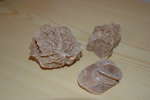
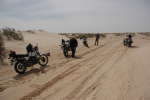
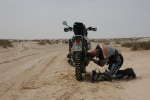

Electrical trouble
We decided to take a little "round trip" on tarmac (El Djergine, Nouil) to visit the Chott.
Indeed it is quite a fascinating sight - you have "coloured" water (often blue or red) with a salt crust around and halophilic plants are growing right in between these salt crystals.
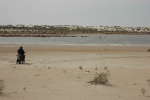
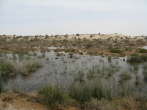
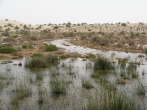
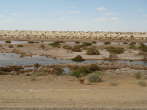
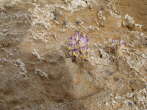
We took lots of pictures and then got back on the bikes. I was looking around to see if everyone was ready to roll and ... Florian was giving me signs. His motorcycle would not start.
The whole dashboard was dark, no light was coming on. Checking and shaking the cables around the battery, suddently the lamps came on again and the bike started as usual.
We were both lucky and happy that this had not happened right in the middle of the desert, one hour earlier!
Since we were on the way back anyway, we decided to postpone a detailed analysis to tomorrow and headed for the camping.
Return to Douz
After the shower, we went into Douz again and to the restaurant "Ali Baba" - a small restaurant with a nice garden.
Temperatures were rather fresh, but the sky was so marvellous that we enjoyed our meal outside.
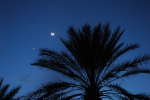
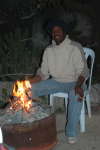
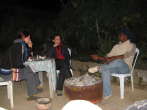
Top | Slideshow
Battery trouble
Indeed we spent the afternoon troubleshooting Lotte and the auxiliary power plug that Hans had installed on his DR750 turned out to be highly useful to "bridge" the two bikes.
After quite a while of testing and measuring, opening and re-fitting long-forgotten cable connectors, scratching oxide layers, removing and re-placing covers, we finally decided to remove the battery
from the bike - which is something we had postponed as long as possible, since the battery is pretty much hidden under the rear subframe of the bike.
Having the battery sitting on the ground, I measured the voltage and found 12.7 V ... perfect.
Unless I left the Voltmeter connected and tilted - no, merely inclined - the battery to one side. The voltage dropped to 10.3 V.
Now, repeat that: Flat, 12.7 V. Inclined to the right, 12.7 V. Inclined to the left, 10.3 V.
Whew. Now this explained why the bike worked, if you shook it in the suitable direction. But anyway: The battery was dead. A SLA-type battery, five years old.
Having found the culprit, the next problem was to get a spare.
Searching a replacement
We went back into the village and zig-zagged through the streets. What we were looking for was a battery in the range of 12 V,
12 to 20 Ah. The problem is just that motorcycles are rare in Tunisia, most of the vélomoteurs do not have 12-V electrics,
and most of the cars around are typically pick-up trucks with Diesel engines ... not a suitable source either.
After having visited a good part of the city, we noticed a sign indicating "quad location". Now, quads are typically based on motorcycles,
so we gave it a try and entered the shop.
It was unusually clean.
The owner gave us a very warm welcome and was immediately ready to help us. We soon found that there was no more fresh battery left in stock
(only an empty packaging), but then he remembered that there was a whole pallet full of old batteries in the back of the shop.
He shrugged his shoulders: "Well, try it .. if you find something that still works, it's perhaps better than nothing!"
Testing with the voltmeter, we found one battery that was still in the 12-V range, so we decided to give it a try. Asking what we had to pay,
the owner of the shop refused any money, indicating that these were old batteries anyway: "If you want, just put your old battery on the pile" ;-)
Thank you very much, Mr. Mohamed Ben Brahim - !
We went back to the camping and installed the battery in Lotte, then hooked it up to Hans' DR750 for some charging and left for dinner.
After yesterday's excellent experience, it was Ali Baba again ;-)
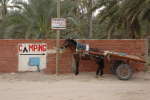
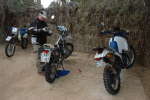
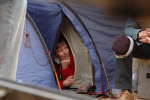
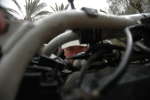
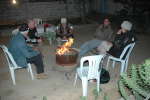
Top | Slideshow
Lotte is alive again
The night was calm (apart from the usual music in the streets - people here seem to like partying ;-) and this was
one of the first nights that was less cold than before. We took our breakfast at the camping (something we can recommend;
it just takes a reservation the evening before), then filled up Lotte's
new old battery with some distilled water
that we had bought at the pharmacy the evening before. Doing some test runs, we found that she indeed fired, but only
in the very first moment you hit the starter button and then again when you released it. The reason was apparently
twofold: First, that battery was still weak. And ... the bike was equipped with a double ignition that was built using two recent BMW ignition coils
in parallel - which means a very low resistance of the circuit and a very high current consumption;
too much for the little and old 8-Ah battery that we had.
We changed the configuration so that the ignition still used both coils, but in series - which meant a slightly less intense
spark, but a fourfold reduction in power consumption. The second modification was to use the conventional spark plugs again,
instead of Iridium plugs ... and indeed she fired up after a few tries!
The only downside was that the "new old" battery has only 8 Ah. While was sufficient to e-start the engine when it was hot, it was not enough
for a cold engine. Fortunately, Lotte was still equipped with a kickstarter, so Florian had his daily sport lesson assured for the next days ;-)
And by the way: this battery brought her home.
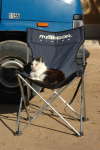
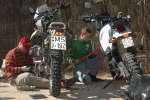
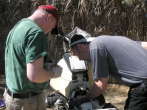
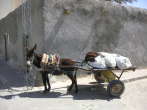
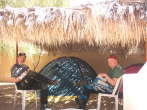
Across the desert
In the meantime petra had bought some sandwiches. We enjoyed them, packed and then left the camping.
Our target was Ksar Ghilane, situated about 80 km southeast of Douz. With the fully loaded bikes we had no intention of taking the direct route, so
we took the road towards the east, which is a "highway" across the desert.
I never thought that it could be so fascinating to ride hours on a straight
road, but the landscape changes steadily, people are waving, camels and mules around ... it was never boring, no - it was phantastic!
About 70 km east of Douz, the route arrives at the Café Jelili, which is quite typical for many little
cafés that are found in this region.
We stopped for the mandatory thé à la menthe and received not only two or three servings of it, but also a bunch
of delicious cookies and coffee.
These are the moments that make such a trip unforgettable.
The road that runs from north to south near Café Jelili is the famous "pipeline piste". It was formerly a harsh track, but when we took this road
the last meters were just covered with tarmac. Thus, the connection between Douz and Ksar Ghilane can now be made completely on tarmac.
The road runs in a straight line towards the south, then reaches another crossing. About 15 km southwest we arrived at today's destination, Ksar Ghilane.
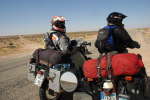
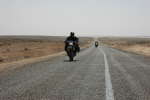

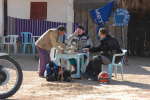
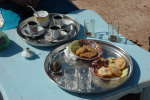
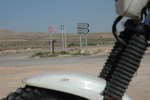
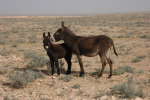
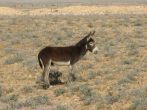
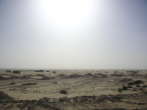
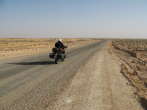
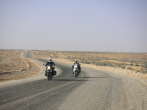
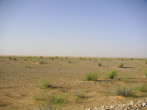
Logistics
- Campement Rhilane, Ksar Ghilane. 25 TD/pers. in "berber tents".
- Total: 146 km.
Top | Slideshow
A short round-trip ... on foot
We stayed in Ksar Ghilane for two nights and today was spent playing in the sand. We started the day strolling through the oasis,
and soon noticed that Ksar Ghilane was a pretty expensive place:
Water costs 1.50 TD per bottle of 1.5 l, which is about three to five times the price you pay in other cities.
A bread (the flat round ones, "Fladenbrot") is sold for a full 1 TD all over the place and the bakers are not willing to discuss the price.
While I can understand that this place is at quite some distance, so you have transportation fees (which is the same situation for a mountain hut
in the Alps), the prices seem to be largely overrated. Compared to the data in the travel guide we used, prices for the Campement Rhilane
had almost doubled since 2004 (half-board: from 15 to 25 TD). A mail exchange that I had with its author after our return indicated indeed
an annual, steep increase of the prices - the German word "Abzocke" (rip off) was deemed appropriate :-(
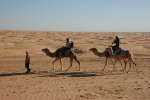
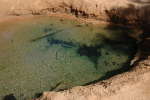
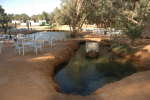
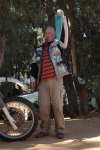
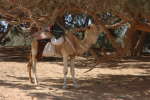
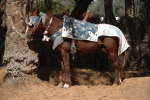
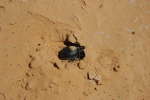
Note: There is another source, with a relatively new camping, about 15...20 south of Ksar Ghilane, at Aïn Essbat.
We briefly visited this place during our following Tunisia trip, in 2008.
Riding to the fort
Ksar Ghilane has been an Tunisian outpost, controlling the sand sea of the Grand Erg Oriental since millenniums. The Romans left a fortress here
(which is "the" Ksar) that was later used by the French ... but it was probably not a very popular place to serve in either army due to its isolation and the heat.
Said fortress it located about 2 km northwest of the oasis and is a well-appreciated site for visits, either walking, riding on a dromedar, or with
a motorized vehicle.
Of course we had to ride there, too. First we tried the direct way, but we had to abandon after merely 1 km - both BMWs got stuck in the sand several times,
Petra dropped her DR upside down after a dune (pretending that it was my fault since I was stuck in the sand just behind this dune ;-) and the wind was rising again,
wiping out our own traces within just a few minutes. We went back on our GPS tracks, then simply a few meters to the west - and were on the rather solid track that is
commonly used by the tourist 4x4s. Using this path, we reached the fort in a few minutes of an easy ride!
The fort itself is slightly elevated and since I got stuck (again!) on the slope that leads up there. It was Florian that finally rode my GS up to the top.
We visited the site - which is surprisingly small -, had a tea in the ubiquituous café, talked to a group of german KTM riders that arrived after us
and left early again and then headed back to the oasis.
Before this trip to Tunisia, I never understood what people found so fascinating in sand riding - but now I do. It's something that
is difficult to describe, something that has nothing to do with street riding and not with gravel riding either. It's quite challenging, but once
you get the hang of it it's a lot of fun.
I soon found out that my GS behaves best in sand when I ride at rather high speed so that the wheels starts to "float" on the sand - at lower speed the bike
easily looses traction and gets stuck. Then again, you cannot ride at any speed you like since you have to look for your way.
An additional factor is the light; if it comes from behind you it can make for a very "interesting" ride since you do not see any structure ;-)
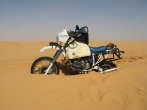
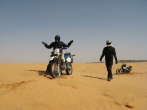
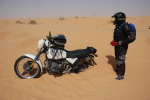
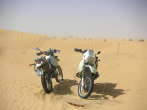
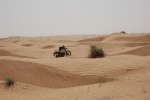
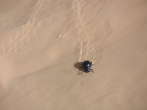
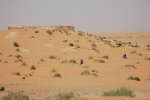
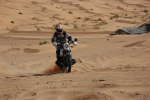
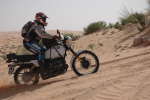
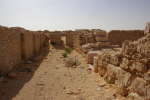
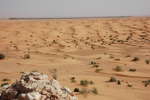
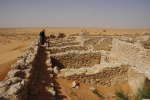
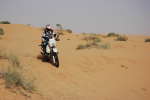
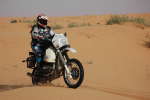

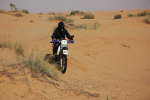
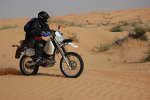
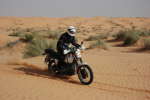
I dumped my GS, for the only time of the whole trip, on the way back from the fort. Quite close to the oasis, I was following Florian over a long but solid sand area,
until he took a steep descent. I saw it, but also knew that my GS would get stuck in the sand when I lost momentum, so I decided to accelerate as much as I could.
The front wheel went over the edge and the next thing I remember was that I was lying next to the bike, with sand flowing into my glove.
No damage, neither to the rider nor the bike; Petra helped me to get her on the wheels again (which is easier said than done in this soft, flowing sand).
And after getting stuck two more times on the same spot I finally got back to the oasis, too.
The afternoon was spent with maintenance ... first, the three of us enjoyed a relaxing session in the hot spring and then the bikes were serviced.
Sand was everywhere and it was time to clean the air filters, too.
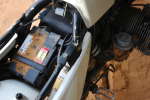
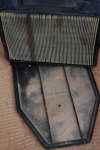
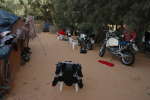
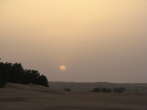
Forward to Part II

















